New Glasgow Nova Scotia sees Tapestry 'Go Theatre'
Town of New Glasgow & St. Andrews Society of Pictou County Presents Scottish Diaspora Tapestry
It's exhibited in Glasgow Square Theatre all 152 metres of Scottish artwork, from Monday, November 7- Saturday, November 12 2016
Viewing Times: 10am-8pm daily except November 11 when 1pm-8pm. Admission at the door $5.
The project involved communities around the world in this outstanding celebration of Scottish heritage and culture, the people and places which connect Scotland to its global diaspora.
Scots have migrated all over the world and have often had a profound impact on the areas where they settled. This beautiful tapestry brings together stories from Scottish communities in 34 countries, documenting their connections in more than 300 embroidered panels. It is a remarkable and heart-felt homage to the determination, courage and achievement of Scottish migrants and their descendants across the centuries.
The Glasgow Square Theatre glistens in East River at night.
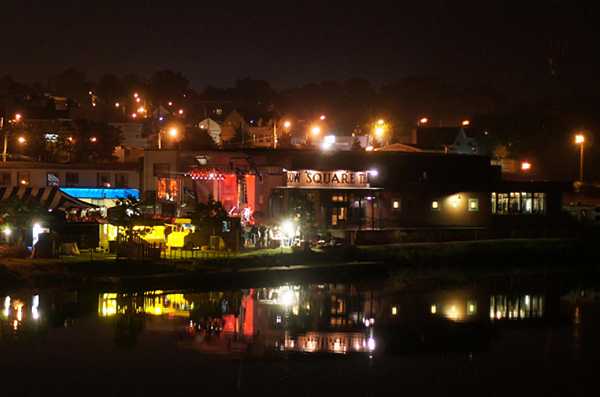
Three panels amongst the 304 have particular interest of course!
Knowing that the Gaelic is well used in Nova Scotia, that text is included below.
click on images to enlarge
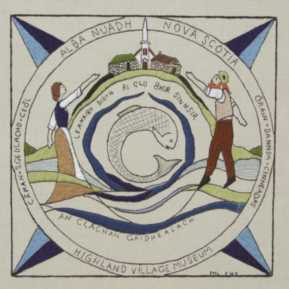 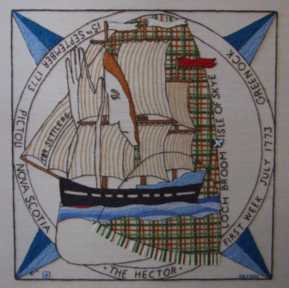
Above left is Panel CA02 Nova Scotia Gaels
Stitchers: Pauline Maclean, Emily MacDonald (Nova Scotia)
The first Scottish settlers in Canada came after Sir William Alexander, Earl of Stirling, was granted land there by King James VI & I in 1621. The land roughly corresponds to modern Nova Scotia and New Brunswick, with parts of Maine and Quebec province. The land was to be called New Scotland (Nova Scotia). Stirling’s son, William Alexander the Younger, constructed Scots Fort (later Charles Fort) in 1629 on land captured from the French. These exploits cost the Alexanders their fortune but were largely in vain: Charles I returned the territory to France in the Treaty of Saint-Germain-en-Laye in 1632.
CA02 Gàidheil Alba Nuadh
Bha fàgail an taighe dhuibh na roghainn dhoirbh ach riatanach do na mìltean de dh’Albannaich. Bha Alba Nuadh a’ riochdachadh dòigh beatha a bha neo-aithnichte agus dùbhlanach le mòran chruadalan, le cànan na Gàidhlig, creideamh agus cleamhnas a’ ceangal nan daoine còmhla ann an coimhearsnachdan. Is e bradan an eòlais ann an cumadh na litreach G suaicheantas na Gàidhlig ann an Alba Nuadh agus tha e a’ taisbeanadh foillseachadh a’ chànain tro a chultar saidhbhir de dh’òran, sgeulachd, ceòl, dannsa is nòsan agus siostam creideimh. Tha Baile Gàidhealach a’ leantainn leis an fhoillseachadh seo air cultar Gàidhlig tro an taisbeanadh agus roinn air cànan, coileanaidhean cultarach, dòighean beatha, ceàird agus cleachdaidhean.
Above right is Panel CA03 The Hector
Stitchers: Alison Jackson, Maureen Fisher, Barbara Grantmyre (Pictou)
In the later 18th century the Highland Clearances forced many Gaelic families to leave Scotland. The first ship of Hebridean colonists arrived on “St John's Island" (Prince Edward Island) in 1770, with more following soon after. In 1773 the Hector landed in Pictou, Nova Scotia, conveying 189 settlers. Most were from Lochbroom on the Isle of Skye. In 1784 a law restricting land-ownership on Cape Breton Island was repealed and soon Prince Edward Island and Nova Scotia were predominantly Gaelic-speaking. It is estimated that more than 50,000 Gaelic settlers immigrated to Nova Scotia and Cape Breton Island between 1815 and 1870.
CA03 An Hector
Aig deireadh an 18mh linn, thug na Fuadaichean air mòran teaghlaichean Gàidhealach Alba fhàgail. Ràinig a’ chiad soitheach de choloinich à Innse Gall “Eilean Naoimh Eòin” (Eilean a’ Phrionnsa) ann an 1770, le tuilleadh a’ leantainn gu luath às dèidh sin. Ann an 1773, chaidh an Hector air tìr ann am Pictou ann an Alba Nuadh a’ giùlain 189 luchd tuineachaidh. Bha a’ mhòr-chuid à Loch Bhraoin ann an taobh siar na Gàidhealtachd. Ann an 1784, chaidh lagh a’ cuibhreachadh seilbh air fearann air Eilean Cheap Breatainn a thilgeil a-mach, agus ann an ùine ghoirid bha Eilean a’ Phrionnsa agus Alba Nuadh sa mhòr-chuid a’ labhairt sa Ghàidhlig. Tha tuairmse gun robh còrr agus 50,000 neachtuineachaidh Gàidhlig air in-imrich ann an Alba Nuadh agus Eilean Cheap Breatainn eadar 1815 agus 1870.
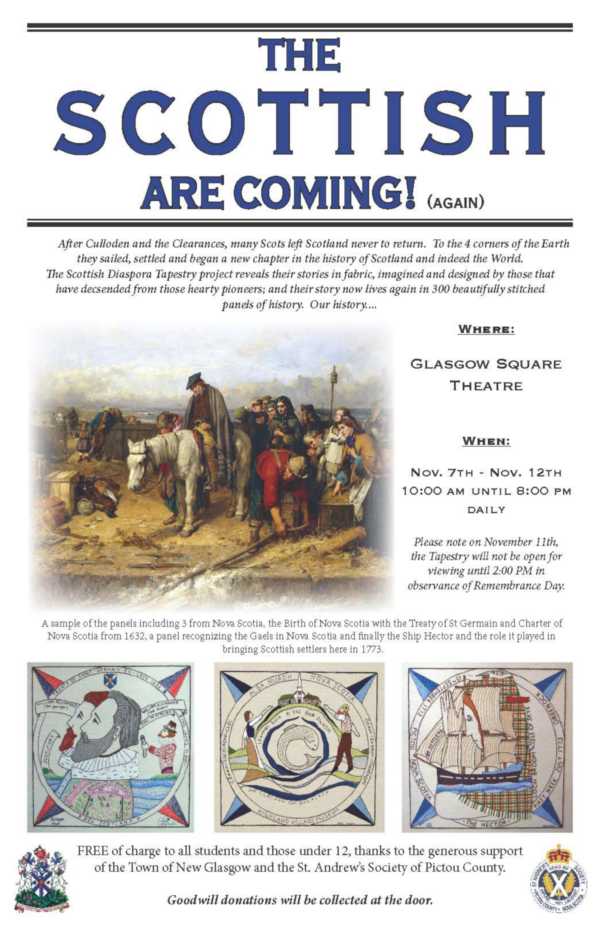
.. actually things got started before Culloden of course both here in Nova Scotia and across the globe
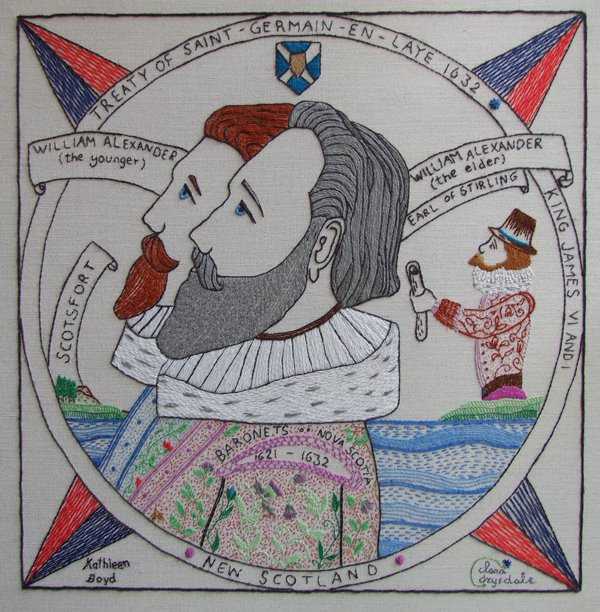
CA01 Treaty of St Germain
Stitchers: Catherine (Kay) Boyd, Clara Drysdale (Pictou)
The first Scottish settlers in Canada came after Sir William Alexander, Earl of Stirling, was granted land there by King James VI & I in 1621. The land roughly corresponds to modern Nova Scotia and New Brunswick, with parts of Maine and Quebec province. The land was to be called New Scotland (Nova Scotia). Stirling’s son, William Alexander the Younger, constructed Scots Fort (later Charles Fort) in 1629 on land captured from the French. These exploits cost the Alexanders their fortune but were largely in vain: Charles I returned the territory to France in the Treaty of Saint-Germain-en-Laye in 1632.
CA01 Cùmhnant St Germain Alba Nuadh
Thàinig a’ chiad luchd-tuineachaidh Albannach a Chanada às dèidh Sir Uilleam Alexander, Iarla Shruighle, air an deach fearann a bhuileachadh an sin le Rìgh Seumas VI & I ann an 1621. B’ e am fearann Scotia agus New Brunswick le pàirtean de Maine agus sgìre Quebec. B’ e Alba Nuadh an t-ainm a bha gu bhith air an tìr ùr. Thog am mac, Uilleam Alexander a b’ òige, an Dùn Albannach (às dèidh sin Dùn Theàrlaich) ann an 1629 air fearann a chaidh a dhleasadh bho na Frangaich. Chosg na cothroman sin am fortan don teaghlach Alexander agus gun adhbhar gu ìre mhòr: thill Teàrlach I an tìr don Fhraing ann an cùmhnant Saint-Germainen-Laye ann an 1632.
Published Date: October 29th 2016
|





